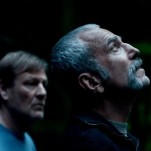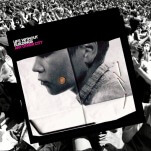Taylor Brown’s Prose in The River of Kings is Reminiscent of Terrence Malick

Badlands director Terrence Malick has been described as “a silent filmmaker who makes films with sound”—where the visuals are so evocative and enduring that the accompanying sounds seem almost unnecessary, given how well the visuals tell the story. Likewise, novelist Taylor Brown might be described as a silent filmmaker who writes so vividly he makes motion pictures with printed words.
Brown’s first novel, the Montana Prize-winning Fallen Land, felt a little like Badlands transplanted to the Blue Ridge Mountains in the waning days of the Civil War, although the endearing outlaw couple at its center killed for survival—not for fun. Brown’s new novel, The River of Kings, journeys through a landscape as threatening and majestic as Fallen Land’s setting. But as the title suggests, this time it’s a river excursion rather than an overland one, and the demons chasing the protagonists—at least at first—are personal and internal.
 The River of Kings delivers three parallel narratives, all of them anchored to Georgia’s Altamaha River. First is the story of the Loggins brothers, college student Hunter and furloughed Navy SEAL Lawton, who set out to kayak the river with their father’s ashes. Brown intersperses the brothers’ river expedition with sequential episodes in the life of their intractable shrimper father Hiram, whose reported death-by-sturgeon doesn’t sit well with Lawton.
The River of Kings delivers three parallel narratives, all of them anchored to Georgia’s Altamaha River. First is the story of the Loggins brothers, college student Hunter and furloughed Navy SEAL Lawton, who set out to kayak the river with their father’s ashes. Brown intersperses the brothers’ river expedition with sequential episodes in the life of their intractable shrimper father Hiram, whose reported death-by-sturgeon doesn’t sit well with Lawton.
But perhaps the most fascinating element of The River of Kings is the third narrative, Brown’s fictionalized interpretation of the French encounter with Timucuan natives at Fort Caroline in the 1560s. Like Miles Harvey, author of Painter in a Savage Land: The Strange Saga of the First European Artist in North America, Brown tells the story through the eyes of Jacques LeMoyne de Morgues, an artist brought along to document the expedition. Failing to establish a permanent settlement at Fort Caroline, LeMoyne and a few others survived mutiny, famine and violent confrontations with the Timucuans—incidents mesmerizingly rendered in The River of Kings. Like LeMoyne’s remarkable drawings, many of which are reproduced in Brown’s novel, the ghosts of the battles and perfidies of 1565 haunt the Loggins brothers’ river journey.
Although Hunter and Lawton enjoy moments of rough brotherly repartee, their trip is fraught with recrimination and encroaching danger, both real and phantasmagorical. The river represents conflicting forces in their lives—their closest connection to a distant father, and a foe as harsh and unforgiving as the man himself, a living thing connecting present and past. As Hiram describes it to his sons in their younger days:
“This river’s always feed you if you needed. People been living on its banks since always. Altamaha himself, he was a river king, and there was tribes long before him, hunting deer and alligator with arrows made from fish teeth. They say there was forts down here, Spanish and French, more’n half a century before that Mayflower shit up north… You ever in trouble, this is the place you come.”
The River of Kings draws its real power not from the variety of its intertwining storylines or its intimations of deep family conflicts, but from the luminous strength of Brown’s writing. Because the force of Brown’s prose never lets up for a sentence, the characters and visuals he creates bore into your brain with a slow, insistent burn. This is true whether he’s describing the inching progress of a river journey, explosions of bone-crunching violence or the turmoil raging within a half-feral river man like Hiram Loggins:
“He looks down at his hands, white-knuckling the railing as if to keep him from going over. Below that the churning waters, white-whipped, cold as slate. His skin is on fire now, his breast bubbling with spite, and he feels like a weapon against the world below his feet. He will leap in, an anchor of superheated hate, and the depths will erupt from him, sizzling and boiling, the waters destroyed in the heat of his rage.”
The River of Kings is almost impossibly visual—cinematic in the best sense. Like Cormac McCarthy and Annie Proulx, Brown possesses rare and wild gifts, writing with the arresting precision and unremitting intensity that can keep a reader’s jaw clenched for books at a time.
Steve Nathans-Kelly is a writer and editor based in Ithaca, New York.







































